ANDROGEL- testosterone gel
Androgel by
Drug Labeling and Warnings
Androgel by is a Prescription medication manufactured, distributed, or labeled by AbbVie Inc.. Drug facts, warnings, and ingredients follow.
Drug Details [pdf]
-
HIGHLIGHTS OF PRESCRIBING INFORMATION
These highlights do not include all the information needed to use ANDROGEL 1.62% safely and effectively. See full prescribing information for ANDROGEL 1.62%.
AndroGel® (testosterone gel) 1.62% for topical use CIII
Initial U.S. Approval: 1953WARNING: SECONDARY EXPOSURE TO TESTOSTERONE
See full prescribing information for complete boxed warning.
- Virilization has been reported in children who were secondarily exposed to testosterone gel (5.2, 6.2).
- Children should avoid contact with unwashed or unclothed application sites in men using testosterone gel (2.2, 5.2).
- Healthcare providers should advise patients to strictly adhere to recommended instructions for use (2.2, 5.2, 17).
INDICATIONS AND USAGE
AndroGel 1.62% is indicated for replacement therapy in males for conditions associated with a deficiency or absence of endogenous testosterone:
- Primary hypogonadism (congenital or acquired) (1)
- Hypogonadotropic hypogonadism (congenital or acquired) (1)
Limitations of use:
- Safety and efficacy of AndroGel 1.62% in men with “age-related hypogonadism” have not been established. (1)
- Safety and efficacy of AndroGel 1.62% in males less than 18 years old have not been established. (1, 8.4)
- Topical testosterone products may have different doses, strengths, or application instructions that may result in different systemic exposure. (1, 12.3)
DOSAGE AND ADMINISTRATION
- Dosage and Administration for AndroGel 1.62% differs from AndroGel 1%. For dosage and administration of AndroGel 1% refer to its full prescribing information. (2)
- Prior to initiating AndroGel 1.62%, confirm the diagnosis of hypogonadism by ensuring that serum testosterone has been measured in the morning on at least two separate days and that these concentrations are below the normal range (2).
- Starting dose of AndroGel 1.62% is 40.5 mg of testosterone (2 pump actuations or a single 40.5 mg packet), applied topically once daily in the morning. (2.1)
- Apply to clean, dry, intact skin of the shoulders and upper arms. Do not apply AndroGel 1.62% to any other parts of the body including the abdomen, genitals, chest, armpits (axillae), or knees. (2.2, 12.3)
- Dose adjustment: AndroGel 1.62% can be dose adjusted between a minimum of 20.25 mg of testosterone (1 pump actuation or a single 20.25 mg packet) and a maximum of 81 mg of testosterone (4 pump actuations or two 40.5 mg packets). The dose should be titrated based on the pre-dose morning serum testosterone concentration at approximately 14 days and 28 days after starting treatment or following dose adjustment. Additionally, serum testosterone concentration should be assessed periodically thereafter. (2.1)
- Patients should wash hands immediately with soap and water after applying AndroGel 1.62% and cover the application site(s) with clothing after the gel has dried. Wash the application site thoroughly with soap and water prior to any situation where skin-to-skin contact of the application site with another person is anticipated. (2.2)
DOSAGE FORMS AND STRENGTHS
CONTRAINDICATIONS
WARNINGS AND PRECAUTIONS
- Monitor patients with benign prostatic hyperplasia (BPH) for worsening of signs and symptoms of BPH (5.1)
- Avoid unintentional exposure of women or children to AndroGel 1.62%. Secondary exposure to testosterone can produce signs of virilization. AndroGel 1.62% should be discontinued until the cause of virilization is identified (5.2)
- Venous thromboembolism (VTE), including deep vein thrombosis (DVT) and pulmonary embolism (PE) have been reported in patients using testosterone products. Evaluate patients with signs or symptoms consistent with DVT or PE. (5.4)
- Some postmarketing studies have shown an increased risk of myocardial infarction and stroke associated with use of testosterone replacement therapy. (5.5)
- Exogenous administration of androgens may lead to azoospermia (5.8)
- Edema with or without congestive heart failure (CHF) may be a complication in patients with preexisting cardiac, renal, or hepatic disease (5.10)
- Sleep apnea may occur in those with risk factors (5.12)
- Monitor serum testosterone, prostate specific antigen (PSA), hemoglobin, hematocrit, liver function tests and lipid concentrations periodically (5.1, 5.3, 5.9, 5.13)
- AndroGel 1.62% is flammable until dry (5.16)
ADVERSE REACTIONS
The most common adverse reaction (incidence ≥ 5%) is an increase in prostate specific antigen (PSA). (6.1)
To report SUSPECTED ADVERSE REACTIONS, contact AbbVie Inc. at 1-800-633-9110 or FDA at 1-800-FDA-1088 or www.fda.gov/medwatch.
DRUG INTERACTIONS
- Androgens may decrease blood glucose and therefore may decrease insulin requirements in diabetic patients (7.1)
- Changes in anticoagulant activity may be seen with androgens. More frequent monitoring of International Normalized Ratio (INR) and prothrombin time is recommended (7.2)
- Use of testosterone with adrenocorticotrophic hormone (ACTH) or corticosteroids may result in increased fluid retention. Use with caution, particularly in patients with cardiac, renal, or hepatic disease (7.3)
USE IN SPECIFIC POPULATIONS
There are insufficient long-term safety data in geriatric patients using AndroGel 1.62% to assess the potential risks of cardiovascular disease and prostate cancer. (8.5)
See 17 for PATIENT COUNSELING INFORMATION and Medication Guide.
Revised: 5/2019
-
Table of Contents
FULL PRESCRIBING INFORMATION: CONTENTS*
WARNING: SECONDARY EXPOSURE TO TESTOSTERONE
1 INDICATIONS AND USAGE
2 DOSAGE AND ADMINISTRATION
2.1 Dosing and Dose Adjustment
2.2 Administration Instructions
3 DOSAGE FORMS AND STRENGTHS
4 CONTRAINDICATIONS
5 WARNINGS AND PRECAUTIONS
5.1 Worsening of Benign Prostatic Hyperplasia (BPH) and Potential Risk of Prostate Cancer
5.2 Potential for Secondary Exposure to Testosterone
5.3 Polycythemia
5.4 Venous Thromboembolism
5.5 Cardiovascular Risk
5.6 Abuse of Testosterone and Monitoring of Serum Testosterone Concentrations
5.7 Use in Women
5.8 Potential for Adverse Effects on Spermatogenesis
5.9 Hepatic Adverse Effects
5.10 Edema
5.11 Gynecomastia
5.12 Sleep Apnea
5.13 Lipids
5.14 Hypercalcemia
5.15 Decreased Thyroxine-binding Globulin
5.16 Flammability
6 ADVERSE REACTIONS
6.1 Clinical Trial Experience
6.2 Postmarketing Experience
7 DRUG INTERACTIONS
7.1 Insulin
7.2 Oral Anticoagulants
7.3 Corticosteroids
8 USE IN SPECIFIC POPULATIONS
8.1 Pregnancy
8.2 Lactation
8.3 Females and Males of Reproductive Potential
8.4 Pediatric Use
8.5 Geriatric Use
8.6 Renal Impairment
8.7 Hepatic Impairment
9 DRUG ABUSE AND DEPENDENCE
9.1 Controlled Substance
9.2 Abuse
9.3 Dependence
10 OVERDOSAGE
11 DESCRIPTION
12 CLINICAL PHARMACOLOGY
12.1 Mechanism of Action
12.2 Pharmacodynamics
12.3 Pharmacokinetics
13 NONCLINICAL TOXICOLOGY
13.1 Carcinogenesis, Mutagenesis, Impairment of Fertility
14 CLINICAL STUDIES
14.1 Clinical Trials in Hypogonadal Males
16 HOW SUPPLIED/STORAGE AND HANDLING
17 PATIENT COUNSELING INFORMATION
17.1 Use in Men with Known or Suspected Prostate or Breast Cancer
17.2 Potential for Secondary Exposure to Testosterone and Steps to Prevent Secondary Exposure
17.3 Potential Adverse Reactions with Androgens
17.4 Patients Should Be Advised of the Following Instructions for Use
- * Sections or subsections omitted from the full prescribing information are not listed.
-
BOXED WARNING
(What is this?)
WARNING: SECONDARY EXPOSURE TO TESTOSTERONE
- Virilization has been reported in children who were secondarily exposed to testosterone gel [see Warnings and Precautions (5.2) and Adverse Reactions (6.2)].
- Children should avoid contact with unwashed or unclothed application sites in men using testosterone gel [see Dosage and Administration (2.2) and Warnings and Precautions (5.2)].
- Healthcare providers should advise patients to strictly adhere to recommended instructions for use [see Dosage and Administration (2.2), Warnings and Precautions (5.2) and Patient Counseling Information (17)].
-
1 INDICATIONS AND USAGE
AndroGel 1.62% is indicated for replacement therapy in adult males for conditions associated with a deficiency or absence of endogenous testosterone:
- Primary hypogonadism (congenital or acquired): testicular failure due to conditions such as cryptorchidism, bilateral torsion, orchitis, vanishing testis syndrome, orchiectomy, Klinefelter's syndrome, chemotherapy, or toxic damage from alcohol or heavy metals. These men usually have low serum testosterone concentrations and gonadotropins (follicle-stimulating hormone [FSH], luteinizing hormone [LH]) above the normal range.
- Hypogonadotropic hypogonadism (congenital or acquired): gonadotropin or luteinizing hormone-releasing hormone (LHRH) deficiency or pituitary-hypothalamic injury from tumors, trauma, or radiation. These men have low testosterone serum concentrations, but have gonadotropins in the normal or low range.
- Safety and efficacy of AndroGel 1.62% in men with “age-related hypogonadism” (also referred to as “late-onset hypogonadism”) have not been established.
- Safety and efficacy of AndroGel 1.62% in males less than 18 years old have not been established [see Use in Specific Populations (8.4)].
- Topical testosterone products may have different doses, strengths, or application instructions that may result in different systemic exposure [see Indications and Usage (1), and Clinical Pharmacology (12.3)].
-
2 DOSAGE AND ADMINISTRATION
Dosage and Administration for AndroGel 1.62% differs from AndroGel 1%. For dosage and administration of AndroGel 1% refer to its full prescribing information. (2)
Prior to initiating AndroGel 1.62%, confirm the diagnosis of hypogonadism by ensuring that serum testosterone concentrations have been measured in the morning on at least two separate days and that these serum testosterone concentrations are below the normal range.
2.1 Dosing and Dose Adjustment
The recommended starting dose of AndroGel 1.62% is 40.5 mg of testosterone (2 pump actuations or a single 40.5 mg packet) applied topically once daily in the morning to the shoulders and upper arms.
The dose can be adjusted between a minimum of 20.25 mg of testosterone (1 pump actuation or a single 20.25 mg packet) and a maximum of 81 mg of testosterone (4 pump actuations or two 40.5 mg packets). To ensure proper dosing, the dose should be titrated based on the pre-dose morning serum testosterone concentration from a single blood draw at approximately 14 days and 28 days after starting treatment or following dose adjustment. In addition, serum testosterone concentration should be assessed periodically thereafter. Table 1 describes the dose adjustments required at each titration step.
Table 1: Dose Adjustment Criteria Pre-Dose Morning Total Serum Testosterone Concentration Dose Titration Greater than 750 ng/dL Decrease daily dose by 20.25 mg (1 pump actuation or the equivalent of one 20.25 mg packet) Equal to or greater than 350 and equal to or less than 750 ng/dL No change: continue on current dose Less than 350 ng/dL Increase daily dose by 20.25 mg (1 pump actuation or the equivalent of one 20.25 mg packet) The application site and dose of AndroGel 1.62% are not interchangeable with other topical testosterone products.
2.2 Administration Instructions
AndroGel 1.62% should be applied to clean, dry, intact skin of the upper arms and shoulders. Do not apply AndroGel 1.62% to any other parts of the body, including the abdomen, genitals, chest, armpits (axillae), or knees [see Clinical Pharmacology (12.3)]. Area of application should be limited to the area that will be covered by the patient's short sleeve t-shirt. Patients should be instructed to use the palm of the hand to apply AndroGel 1.62% and spread across the maximum surface area as directed in Table 2 (for pump) and Table 3 (for packets) and in Figure 1.
Table 2: Application Sites for AndroGel 1.62%, Pump Total Dose of Testosterone Total Pump Actuations Pump Actuations Per Upper Arm and Shoulder Upper Arm and Shoulder #1 Upper Arm and Shoulder #2 20.25 mg 1 1 0 40.5 mg 2 1 1 60.75 mg 3 2 1 81 mg 4 2 2 Table 3: Application Sites for AndroGel 1.62%, Packets
Total Dose of Testosterone Total packets Gel Applications Per Upper Arm and Shoulder Upper Arm and Shoulder #1 Upper Arm and Shoulder #2 20.25 mg One 20.25 mg packet One 20.25 mg packet 0 40.5 mg One 40.5 mg packet Half of contents of One
40.5 mg packetHalf of contents of One
40.5 mg packet60.75 mg One 20.25 mg packet AND
One 40.5 mg packetOne 40.5 mg packet One 20.25 mg packet 81 mg Two 40.5 mg packets One 40.5 mg packet One 40.5 mg packet The prescribed daily dose of AndroGel 1.62% should be applied to the right and left upper arms and shoulders as shown in the shaded areas in Figure 1.
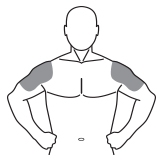
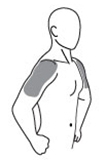
Figure 1. Application Sites for AndroGel 1.62%
Once the application site is dry, the site should be covered with clothing [see Clinical Pharmacology (12.3)]. Wash hands thoroughly with soap and water. Avoid fire, flames or smoking until the gel has dried since alcohol based products, including AndroGel 1.62%, are flammable.
The patient should avoid swimming or showering or washing the administration site for a minimum of 2 hours after application [see Clinical Pharmacology (12.3)].
To obtain a full first dose, it is necessary to prime the canister pump. To do so, with the canister in the upright position, slowly and fully depress the actuator three times. Safely discard the gel from the first three actuations. It is only necessary to prime the pump before the first dose.
After the priming procedure, fully depress the actuator once for every 20.25 mg of AndroGel 1.62%. AndroGel 1.62% should be delivered directly into the palm of the hand and then applied to the application sites.
When using packets, the entire contents should be squeezed into the palm of the hand and immediately applied to the application sites. When 40.5 mg packets need to be split between the left and right shoulder, patients may squeeze a portion of the gel from the packet into the palm of the hand and apply to application sites. Repeat until entire contents have been applied. Alternatively, AndroGel 1.62% can be applied directly to the application sites from the pump or packets.
Strict adherence to the following precautions is advised in order to minimize the potential for secondary exposure to testosterone from AndroGel 1.62%-treated skin:
- Children and women should avoid contact with unwashed or unclothed application site(s) of men using AndroGel 1.62%.
- AndroGel 1.62% should only be applied to the upper arms and shoulders. The area of application should be limited to the area that will be covered by a short sleeve t-shirt.
- Patients should wash their hands with soap and water immediately after applying AndroGel 1.62%.
- Patients should cover the application site(s) with clothing (e.g., a t-shirt) after the gel has dried.
- Prior to situations in which direct skin-to-skin contact is anticipated, patients should wash the application site(s) thoroughly with soap and water to remove any testosterone residue.
- In the event that unwashed or unclothed skin to which AndroGel 1.62% has been applied comes in direct contact with the skin of another person, the general area of contact on the other person should be washed with soap and water as soon as possible.
-
3 DOSAGE FORMS AND STRENGTHS
AndroGel (testosterone gel) 1.62% for topical use only, is available as follows:
- A metered-dose pump. Each pump actuation delivers 20.25 mg of testosterone in 1.25 g of gel.
- A unit dose packet containing 20.25 mg of testosterone in 1.25 g of gel.
- A unit dose packet containing 40.5 mg of testosterone in 2.5 g of gel.
-
4 CONTRAINDICATIONS
- AndroGel 1.62% is contraindicated in men with carcinoma of the breast or known or suspected carcinoma of the prostate [see Warnings and Precautions (5.1) and Adverse Reactions (6.1)].
- AndroGel 1.62% is contraindicated in women who are pregnant. AndroGel 1.62% can cause virilization of the female fetus when administered to a pregnant woman. Pregnant women need to be aware of the potential for transfer of testosterone from men treated with AndroGel 1.62%. If a pregnant woman is exposed to AndroGel 1.62%, she should be apprised of the potential hazard to the fetus [see Warnings and Precautions (5.2) and Use in Specific Populations (8.1)].
-
5 WARNINGS AND PRECAUTIONS
5.1 Worsening of Benign Prostatic Hyperplasia (BPH) and Potential Risk of Prostate Cancer
- Patients with BPH treated with androgens are at an increased risk for worsening of signs and symptoms of BPH. Monitor patients with BPH for worsening signs and symptoms.
- Patients treated with androgens may be at increased risk for prostate cancer. Evaluation of patients for prostate cancer prior to initiating and during treatment with androgens is appropriate [see Contraindications (4)].
5.2 Potential for Secondary Exposure to Testosterone
Cases of secondary exposure resulting in virilization of children have been reported in postmarketing surveillance of testosterone gel products. Signs and symptoms have included enlargement of the penis or clitoris, development of pubic hair, increased erections and libido, aggressive behavior, and advanced bone age. In most cases, these signs and symptoms regressed with removal of the exposure to testosterone gel. In a few cases, however, enlarged genitalia did not fully return to age-appropriate normal size, and bone age remained modestly greater than chronological age. The risk of transfer was increased in some of these cases by not adhering to precautions for the appropriate use of the topical testosterone product. Children and women should avoid contact with unwashed or unclothed application sites in men using AndroGel 1.62% [see Dosage and Administration (2.2), Use in Specific Populations (8.1) and Clinical Pharmacology (12.3)].
Inappropriate changes in genital size or development of pubic hair or libido in children, or changes in body hair distribution, significant increase in acne, or other signs of virilization in adult women should be brought to the attention of a physician and the possibility of secondary exposure to testosterone gel should also be brought to the attention of a physician. Testosterone gel should be promptly discontinued until the cause of virilization has been identified.
5.3 Polycythemia
Increases in hematocrit, reflective of increases in red blood cell mass, may require lowering or discontinuation of testosterone. Check hematocrit prior to initiating treatment. It would also be appropriate to re-evaluate the hematocrit 3 to 6 months after starting treatment, and then annually. If hematocrit becomes elevated, stop therapy until hematocrit decreases to an acceptable concentration. An increase in red blood cell mass may increase the risk of thromboembolic events.
5.4 Venous Thromboembolism
There have been postmarketing reports of venous thromboembolic events, including deep vein thrombosis (DVT) and pulmonary embolism (PE), in patients using testosterone products such as AndroGel 1.62%. Evaluate patients who report symptoms of pain, edema, warmth and erythema in the lower extremity for DVT and those who present with acute shortness of breath for PE. If a venous thromboembolic event is suspected, discontinue treatment with AndroGel 1.62% and initiate appropriate workup and management [see Adverse Reactions (6.2)].
5.5 Cardiovascular Risk
Long term clinical safety trials have not been conducted to assess the cardiovascular outcomes of testosterone replacement therapy in men. To date, epidemiologic studies and randomized controlled trials have been inconclusive for determining the risk of major adverse cardiovascular events (MACE), such as non-fatal myocardial infarction, non-fatal stroke, and cardiovascular death, with the use of testosterone compared to non-use. Some studies, but not all, have reported an increased risk of MACE in association with use of testosterone replacement therapy in men.
Patients should be informed of this possible risk when deciding whether to use or to continue to use AndroGel 1.62%.
5.6 Abuse of Testosterone and Monitoring of Serum Testosterone Concentrations
Testosterone has been subject to abuse, typically at doses higher than recommended for the approved indication and in combination with other anabolic androgenic steroids. Anabolic androgenic steroid abuse can lead to serious cardiovascular and psychiatric adverse reactions [see Drug Abuse and Dependence (9)].
If testosterone abuse is suspected, check serum testosterone concentrations to ensure they are within therapeutic range. However, testosterone levels may be in the normal or subnormal range in men abusing synthetic testosterone derivatives. Counsel patients concerning the serious adverse reactions associated with abuse of testosterone and anabolic androgenic steroids. Conversely, consider the possibility of testosterone and anabolic androgenic steroid abuse in suspected patients who present with serious cardiovascular or psychiatric adverse events.
5.7 Use in Women
Due to the lack of controlled evaluations in women and potential virilizing effects, AndroGel 1.62% is not indicated for use in women [see Contraindications (4) and Use in Specific Populations (8.1, 8.2)].
5.8 Potential for Adverse Effects on Spermatogenesis
With large doses of exogenous androgens, including AndroGel 1.62%, spermatogenesis may be suppressed through feedback inhibition of pituitary FSH possibly leading to adverse effects on semen parameters including sperm count.
5.9 Hepatic Adverse Effects
Prolonged use of high doses of orally active 17-alpha-alkyl androgens (e.g., methyltestosterone) has been associated with serious hepatic adverse effects (peliosis hepatis, hepatic neoplasms, cholestatic hepatitis, and jaundice). Peliosis hepatis can be a life-threatening or fatal complication. Long-term therapy with intramuscular testosterone enanthate has produced multiple hepatic adenomas. AndroGel 1.62% is not known to cause these adverse effects.
5.10 Edema
Androgens, including AndroGel 1.62%, may promote retention of sodium and water. Edema, with or without congestive heart failure, may be a serious complication in patients with preexisting cardiac, renal, or hepatic disease [see Adverse Reactions (6.2)].
5.11 Gynecomastia
Gynecomastia may develop and persist in patients being treated with androgens, including AndroGel 1.62%, for hypogonadism.
5.12 Sleep Apnea
The treatment of hypogonadal men with testosterone may potentiate sleep apnea in some patients, especially those with risk factors such as obesity or chronic lung diseases.
5.13 Lipids
Changes in serum lipid profile may require dose adjustment or discontinuation of testosterone therapy.
5.14 Hypercalcemia
Androgens, including AndroGel 1.62 %, should be used with caution in cancer patients at risk of hypercalcemia (and associated hypercalciuria). Regular monitoring of serum calcium concentrations is recommended in these patients.
5.15 Decreased Thyroxine-binding Globulin
Androgens, including AndroGel 1.62%, may decrease concentrations of thyroxin-binding globulins, resulting in decreased total T4 serum concentrations and increased resin uptake of T3 and T4. Free thyroid hormone concentrations remain unchanged, however, and there is no clinical evidence of thyroid dysfunction.
-
6 ADVERSE REACTIONS
6.1 Clinical Trial Experience
Because clinical trials are conducted under widely varying conditions, adverse reaction rates observed in the clinical trials of a drug cannot be directly compared to rates in the clinical trials of another drug and may not reflect the rates observed in practice.
AndroGel 1.62% was evaluated in a two-phase, 364-day, controlled clinical study. The first phase was a multi-center, randomized, double-blind, parallel-group, placebo-controlled period of 182 days, in which 234 hypogonadal men were treated with AndroGel 1.62% and 40 received placebo. Patients could continue in an open-label, non-comparative, maintenance period for an additional 182 days [see Clinical Studies (14.1)].
The most common adverse reaction reported in the double-blind period was increased prostate specific antigen (PSA) reported in 26 AndroGel 1.62%-treated patients (11.1%). In 17 patients, increased PSA was considered an adverse event by meeting one of the two pre-specified criteria for abnormal PSA values, defined as (1) average serum PSA >4 ng/mL based on two separate determinations, or (2) an average change from baseline in serum PSA of greater than 0.75 ng/mL on two determinations.
During the 182-day, double-blind period of the clinical trial, the mean change in serum PSA value was 0.14 ng/mL for patients receiving AndroGel 1.62% and -0.12 ng/mL for the patients in the placebo group. During the double-blind period, seven patients had a PSA value >4.0 ng/mL, four of these seven patients had PSA less than or equal to 4.0 ng/mL upon repeat testing. The other three patients did not undergo repeat PSA testing.
During the 182-day, open-label period of the study, the mean change in serum PSA values was 0.10 ng/mL for both patients continuing on active therapy and patients transitioning onto active from placebo. During the open-label period, three patients had a serum PSA value > 4.0 ng/mL, two of whom had a serum PSA less than or equal to 4.0 ng/mL upon repeated testing. The other patient did not undergo repeat PSA testing. Among previous placebo patients, 3 of 28 (10.7%), had increased PSA as an adverse event in the open-label period.
Table 4 shows adverse reactions reported by >2% of patients in the 182-day, double-blind period of the AndroGel 1.62% clinical trial and more frequent in the AndroGel 1.62% treated group versus placebo.
Other adverse reactions occurring in less than or equal to 2% of AndroGel 1.62%-treated patients and more frequently than placebo included: frequent urination, and hyperlipidemia.
In the open-label period of the study (N=191), the most commonly reported adverse reaction (experienced by greater than 2% of patients) was increased PSA (n=13; 6.2%) and sinusitis. Other adverse reactions reported by less than or equal to 2% of patients included increased hemoglobin or hematocrit, hypertension, acne, libido decreased, insomnia, and benign prostatic hypertrophy.
During the 182-day, double-blind period of the clinical trial, 25 AndroGel 1.62%-treated patients (10.7%) discontinued treatment because of adverse reactions. These adverse reactions included 17 patients with PSA increased and 1 report each of: hematocrit increased, blood pressure increased, frequent urination, diarrhea, fatigue, pituitary tumor, dizziness, skin erythema and skin nodule (same patient – neither at application site), vasovagal syncope, and diabetes mellitus. During the 182-day, open-label period, 9 patients discontinued treatment because of adverse reactions. These adverse reactions included 6 reports of PSA increased, 2 of hematocrit increased, and 1 each of triglycerides increased and prostate cancer.
In the 182-day double-blind period of the study, application site reactions were reported in two (2/234; 0.9%) patients receiving AndroGel 1.62%, both of which resolved. Neither of these patients discontinued the study due to application site adverse reactions. In the open-label period of the study, application site reactions were reported in three (3/219; 1.4%) additional patients that were treated with AndroGel 1.62%. None of these subjects were discontinued from the study due to application site reactions.
6.2 Postmarketing Experience
The following adverse reactions have been identified during post approval use of AndroGel 1%. Because the reactions are reported voluntarily from a population of uncertain size, it is not always possible to reliably estimate their frequency or establish a causal relationship to drug exposure (Table 5).
Secondary Exposure to Testosterone in Children
Cases of secondary exposure to testosterone resulting in virilization of children have been reported in postmarketing surveillance of testosterone gel products. Signs and symptoms of these reported cases have included enlargement of the clitoris (with surgical intervention) or the penis, development of pubic hair, increased erections and libido, aggressive behavior, and advanced bone age. In most cases with a reported outcome, these signs and symptoms were reported to have regressed with removal of the testosterone gel exposure. In a few cases, however, enlarged genitalia did not fully return to age appropriate normal size, and bone age remained modestly greater than chronological age. In some of the cases, direct contact with the sites of application on the skin of men using testosterone gel was reported. In at least one reported case, the reporter considered the possibility of secondary exposure from items such as the testosterone gel user's shirts and/or other fabric, such as towels and sheets [see Warnings and Precautions (5.2)].
-
7 DRUG INTERACTIONS
7.1 Insulin
Changes in insulin sensitivity or glycemic control may occur in patients treated with androgens. In diabetic patients, the metabolic effects of androgens may decrease blood glucose and, therefore, may decrease insulin requirements.
-
8 USE IN SPECIFIC POPULATIONS
8.1 Pregnancy
AndroGel 1.62% is contraindicated in pregnant women. Testosterone is teratogenic and may cause fetal harm when administered to a pregnant woman based on data from animal studies and its mechanism of action [see Contraindications (4) and Clinical Pharmacology (12.1)]. Exposure of a female fetus to androgens may result in varying degrees of virilization. In animal developmental studies, exposure to testosterone in utero resulted in hormonal and behavioral changes in offspring and structural impairments of reproductive tissues in female and male offspring. These studies did not meet current standards for nonclinical development toxicity studies.
In developmental studies conducted in rats, rabbits, pigs, sheep and rhesus monkeys, pregnant animals received intramuscular injection of testosterone during the period of organogenesis. Testosterone treatment at doses that were comparable to those used for testosterone replacement therapy resulted in structural impairments in both female and male offspring. Structural impairments observed in females included increased ano-genital distance, phallus development, empty scrotum, no external vagina, intrauterine growth retardation, reduced ovarian reserve, and increased ovarian follicular recruitment. Structural impairments seen in male offspring included increased testicular weight, larger seminal tubular lumen diameter, and higher frequency of occluded tubule lumen. Increased pituitary weight was seen in both sexes.
Testosterone exposure in utero also resulted in hormonal and behavioral changes in offspring. Hypertension was observed in pregnant female rats and their offspring exposed to doses approximately twice those used fortestosterone replacement therapy.
8.3 Females and Males of Reproductive Potential
Testis disorder, testicular atrophy, and oligospermia have been identified during use of AndroGel 1.62% [see Adverse Reactions (6.1, 6.2)].
During treatment with large doses of exogenous androgens, including AndroGel 1.62%, spermatogenesis may be suppressed through feedback inhibition of the hypothalamic-pituitary-testicular axis [see Warnings and Precautions (5.8)]. Reduced fertility is observed in some men taking testosterone replacement therapy. Testicular atrophy, subfertility, and infertility have also been reported in men who abuse anabolic androgenic steroids [see Drug Abuse and Dependence (9.2)]. With either type of use, the impact on fertility may be irreversible.
8.4 Pediatric Use
The safety and effectiveness of AndroGel 1.62% in pediatric patients less than 18 years old has not been established. Improper use may result in acceleration of bone age and premature closure of epiphyses.
8.5 Geriatric Use
There have not been sufficient numbers of geriatric patients involved in controlled clinical studies utilizing AndroGel 1.62% to determine whether efficacy in those over 65 years of age differs from younger subjects. Of the 234 patients enrolled in the clinical trial utilizing AndroGel 1.62%, 21 were over 65 years of age. Additionally, there is insufficient long-term safety data in geriatric patients to assess the potentially increased risks of cardiovascular disease and prostate cancer.
Geriatric patients treated with androgens may also be at risk for worsening of signs and symptoms of BPH.
-
9 DRUG ABUSE AND DEPENDENCE
9.1 Controlled Substance
AndroGel 1.62% contains testosterone, a Schedule III controlled substance in the Controlled Substances Act.
9.2 Abuse
Drug abuse is intentional non-therapeutic use of a drug, even once, for its rewarding psychological and physiological effects. Abuse and misuse of testosterone are seen in male and female adults and adolescents. Testosterone, often in combination with other anabolic androgenic steroids (AAS), and not obtained by prescription through a pharmacy, may be abused by athletes and bodybuilders. There have been reports of misuse by men taking higher doses of legally obtained testosterone than prescribed and continuing testosterone despite adverse events or against medical advice.
Abuse-Related Adverse Reactions
Serious adverse reactions have been reported in individuals who abuse anabolic androgenic steroids and include cardiac arrest, myocardial infarction, hypertrophic cardiomyopathy, congestive heart failure, cerebrovascular accident, hepatotoxicity, and serious psychiatric manifestations, including major depression, mania, paranoia, psychosis, delusions, hallucinations, hostility and aggression.
The following adverse reactions have also been reported in men: transient ischemic attacks, convulsions, hypomania, irritability, dyslipidemias, testicular atrophy, subfertility, and infertility.
The following additional adverse reactions have been reported in women: hirsutism, virilization, deepening of voice, clitoral enlargement, breast atrophy, male-pattern baldness, and menstrual irregularities.
The following adverse reactions have been reported in male and female adolescents: premature closure of bony epiphyses with termination of growth, and precocious puberty.
Because these reactions are reported voluntarily from a population of uncertain size and may include abuse of other agents, it is not always possible to reliably estimate their frequency or establish a causal relationship to drug exposure.
9.3 Dependence
Behaviors Associated with Addiction
Continued abuse of testosterone and other anabolic steroids, leading to addiction is characterized by the following behaviors:
- Taking greater dosages than prescribed
- Continued drug use despite medical and social problems due to drug use
- Spending significant time to obtain the drug when supplies of the drug are interrupted
- Giving a higher priority to drug use than other obligations
- Having difficulty in discontinuing the drug despite desires and attempts to do so
- Experiencing withdrawal symptoms upon abrupt discontinuation of use
Physical dependence is characterized by withdrawal symptoms after abrupt drug discontinuation or a significant dose reduction of a drug. Individuals taking supratherapeutic doses of testosterone may experience withdrawal symptoms lasting for weeks or months which include depressed mood, major depression, fatigue, craving, restlessness, irritability, anorexia, insomnia, decreased libido and hypogonadotropic hypogonadism.
Drug dependence in individuals using approved doses of testosterone for approved indications has not been documented.
-
10 OVERDOSAGE
There is a single report of acute overdosage after parenteral administration of an approved testosterone product in the literature. This subject had serum testosterone concentrations of up to 11,400 ng/dL, which were implicated in a cerebrovascular accident. There were no reports of overdosage in the AndroGel 1.62% clinical trial.
Treatment of overdosage would consist of discontinuation of AndroGel 1.62%, washing the application site with soap and water, and appropriate symptomatic and supportive care.
-
11 DESCRIPTION
AndroGel 1.62% for topical use is a clear, colorless gel containing testosterone. Testosterone is an androgen. AndroGel 1.62% is available in a metered-dose pump or unit dose packets.
The active pharmacologic ingredient in AndroGel 1.62% is testosterone. Testosterone USP is a white to almost white powder chemically described as 17-beta hydroxyandrost-4-en-3-one. The structural formula is:
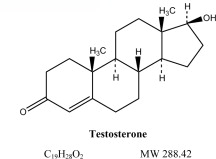
The inactive ingredients in AndroGel 1.62% are: carbopol 980, ethyl alcohol, isopropyl myristate, purified water, and sodium hydroxide.
-
12 CLINICAL PHARMACOLOGY
12.1 Mechanism of Action
Endogenous androgens, including testosterone and dihydrotestosterone (DHT), are responsible for the normal growth and development of the male sex organs and for maintenance of secondary sex characteristics. These effects include the growth and maturation of prostate, seminal vesicles, penis and scrotum; the development of male hair distribution, such as facial, pubic, chest and axillary hair; laryngeal enlargement; vocal chord thickening; and alterations in body musculature and fat distribution. Testosterone and DHT are necessary for the normal development of secondary sex characteristics.
Male hypogonadism, a clinical syndrome resulting from insufficient secretion of testosterone, has two main etiologies. Primary hypogonadism is caused by defects of the gonads, such as Klinefelter's syndrome or Leydig cell aplasia, whereas secondary hypogonadism is the failure of the hypothalamus (or pituitary) to produce sufficient gonadotropins (FSH, LH).
12.3 Pharmacokinetics
AndroGel 1.62% delivers physiologic amounts of testosterone, producing circulating testosterone concentrations that approximate normal levels (300 – 1000 ng/dL) seen in healthy men. AndroGel 1.62% provides continuous transdermal delivery of testosterone for 24 hours following once daily application to clean, dry, intact skin of the shoulders and upper arms. Average serum testosterone concentrations over 24 hours (Cavg) observed when AndroGel 1.62% was applied to the upper arms/shoulders were comparable to average serum testosterone concentrations (Cavg) when AndroGel 1.62% was applied using a rotation method utilizing the abdomen and upper arms/shoulders. The rotation of abdomen and upper arms/shoulders was a method used in the pivotal clinical trial [see Clinical Studies (14.1)].
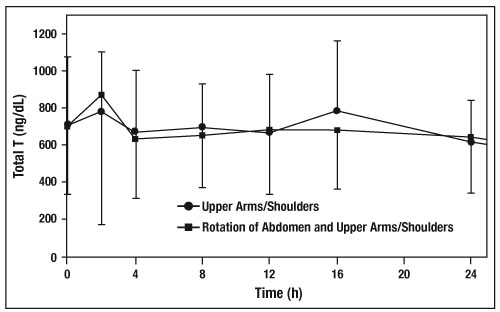
Figure 2: Mean (±SD) Serum Total Testosterone Concentrations on Day 7 in Patients Following AndroGel 1.62% Once-Daily Application of 81 mg of Testosterone (N=33) for 7 Days
Circulating testosterone is primarily bound in the serum to sex hormone-binding globulin (SHBG) and albumin. Approximately 40% of testosterone in plasma is bound to SHBG, 2% remains unbound (free) and the rest is loosely bound to albumin and other proteins.
Testosterone is metabolized to various 17-keto steroids through two different pathways. The major active metabolites of testosterone are estradiol and DHT.
There is considerable variation in the half-life of testosterone concentration as reported in the literature, ranging from 10 to 100 minutes. About 90% of a dose of testosterone given intramuscularly is excreted in the urine as glucuronic acid and sulfuric acid conjugates of testosterone and its metabolites. About 6% of a dose is excreted in the feces, mostly in the unconjugated form. Inactivation of testosterone occurs primarily in the liver.
When AndroGel 1.62% treatment is discontinued, serum testosterone concentrations return to approximately baseline concentrations within 48-72 hours after administration of the last dose.
Potential for testosterone transfer
The potential for testosterone transfer following administration of AndroGel 1.62% when it was applied only to upper arms/shoulders was evaluated in two clinical studies of males dosed with AndroGel 1.62% and their untreated female partners. In one study, 8 male subjects applied a single dose of AndroGel 1.62% 81 mg to their shoulders and upper arms. Two (2) hours after application, female subjects rubbed their hands, wrists, arms, and shoulders to the application site of the male subjects for 15 minutes. Serum concentrations of testosterone were monitored in female subjects for 24 hours after contact occurred. After direct skin-to-skin contact with the site of application, mean testosterone Cavg and Cmax in female subjects increased by 280% and 267%, respectively, compared to mean baseline testosterone concentrations. In a second study evaluating transfer of testosterone, 12 male subjects applied a single dose of AndroGel 1.62% 81 mg to their shoulders and upper arms. Two (2) hours after application, female subjects rubbed their hands, wrists, arms, and shoulders to the application site of the male subjects for 15 minutes while the site of application was covered by a t-shirt. When a t-shirt was used to cover the site of application, mean testosterone Cavg and Cmax in female subjects increased by 6% and 11%, respectively, compared to mean baseline testosterone concentrations.
A separate study was conducted to evaluate the potential for testosterone transfer from 16 males dosed with AndroGel 1.62% 81 mg when it was applied to abdomen only for 7 days, a site of application not approved for AndroGel 1.62%. Two (2) hours after application to the males on each day, the female subjects rubbed their abdomens for 15 minutes to the abdomen of the males. The males had covered the application area with a T-shirt. The mean testosterone Cavg and Cmax in female subjects on day 1 increased by 43% and 47%, respectively, compared to mean baseline testosterone concentrations. The mean testosterone Cavg and Cmax in female subjects on day 7 increased by 60% and 58%, respectively, compared to mean baseline testosterone concentrations.
In a randomized, 3-way (3 treatment periods without washout period) crossover study in 24 hypogonadal men, the effect of showering on testosterone exposure was assessed after once daily application of AndroGel 1.62% 81 mg to upper arms/shoulders for 7 days in each treatment period. On the 7th day of each treatment period, hypogonadal men took a shower with soap and water at either 2, 6, or 10 hours after drug application. The effect of showering at 2 or 6 hours post-dose on Day 7 resulted in 13% and 12% decreases in mean Cavg, respectively, compared to Day 6 when no shower was taken after drug application. Showering at 10 hours after drug application had no effect on bioavailability. The amount of testosterone remaining in the outer layers of the skin at the application site on the 7th day was assessed using a tape stripping procedure and was reduced by at least 80% after showering 2-10 hours post-dose compared to on the 6th day when no shower was taken after drug application.
In a randomized, open-label, single-dose, 2-way crossover study in 16 healthy male subjects, the effect of hand washing on the amount of residual testosterone on the hands was evaluated. Subjects used their hands to apply the maximum dose (81 mg testosterone) of AndroGel 1.62% to their upper arms and shoulders. Within 1 minute of applying the gel, subjects either washed or did not wash their hands prior to study personnel wiping the subjects’ hands with ethanol dampened gauze pads. The gauze pads were then analyzed for residual testosterone content. A mean (SD) of 0.1 (0.04) mg of residual testosterone (0.12% of the actual applied dose of testosterone, and a 96% reduction compared to when hands were not washed) was recovered after washing hands with water and soap.
Effect of sunscreen or moisturizing lotion on absorption of testosterone
In a randomized, 3-way (3 treatment periods without washout period) crossover study in 18 hypogonadal males, the effect of applying a moisturizing lotion or a sunscreen on the absorption of testosterone was evaluated with the upper arms/shoulders as application sites. For 7 days, moisturizing lotion or sunscreen (SPF 50) was applied daily to the AndroGel 1.62% application site 1 hour after the application of AndroGel 1.62% 40.5 mg. Application of moisturizing lotion increased mean testosterone Cavg and Cmax by 14% and 17%, respectively, compared to AndroGel 1.62% administered alone. Application of sunscreen increased mean testosterone Cavg and Cmax by 8% and 13%, respectively, compared to AndroGel 1.62% applied alone.
-
13 NONCLINICAL TOXICOLOGY
13.1 Carcinogenesis, Mutagenesis, Impairment of Fertility
Testosterone has been tested by subcutaneous injection and implantation in mice and rats. In mice, the implant induced cervical-uterine tumors which metastasized in some cases. There is suggestive evidence that injection of testosterone into some strains of female mice increases their susceptibility to hepatoma. Testosterone is also known to increase the number of tumors and decrease the degree of differentiation of chemically induced carcinomas of the liver in rats.
Testosterone was negative in the in vitro Ames and in the in vivo mouse micronucleus assays.
The administration of exogenous testosterone has been reported to suppress spermatogenesis in rats, dogs, and non-human primates, which was reversible on cessation of the treatment.
-
14 CLINICAL STUDIES
14.1 Clinical Trials in Hypogonadal Males
AndroGel 1.62% was evaluated in a multi-center, randomized, double-blind, parallel-group, placebo-controlled study (182-day double-blind period) in 274 hypogonadal men with body mass index (BMI) 18-40 kg/m2 and 18-80 years of age (mean age 53.8 years). The patients had an average serum testosterone concentration of <300 ng/dL, as determined by two morning samples collected on the same visit. Patients were Caucasian 83%, Black 13%, Asian or Native American 4%. 7.5% of patients were Hispanic.
Patients were randomized to receive active treatment or placebo using a rotation method utilizing the abdomen and upper arms/shoulders for 182 days. All patients were started at a daily dose of 40.5 mg (two pump actuations) AndroGel 1.62% or matching placebo on Day 1 of the study. Patients returned to the clinic on Day 14, Day 28, and Day 42 for predose serum total testosterone assessments. The patient's daily dose was titrated up or down in 20.25 mg increments if the predose serum testosterone value was outside the range of 350-750 ng/dL. The study included four active AndroGel 1.62% doses: 20.25 mg, 40.5 mg, 60.75 mg, and 81 mg daily.
The primary endpoint was the percentage of patients with Cavg within the normal range of 300-1000 ng/dL on Day 112. In patients treated with AndroGel 1.62%, 81.6% (146/179) had Cavg within the normal range at Day 112. The secondary endpoint was the percentage of patients, with Cmax above three pre-determined limits. The percentages of patients with Cmax greater than 1500 ng/dL, and between 1800 and 2499 ng/dL on Day 112 were 11.2% and 5.5%, respectively. Two patients had a Cmax >2500 ng/dL on Day 112 (2510 ng/dL and 2550 ng/dL, respectively); neither of these 2 patients demonstrated an abnormal Cmax on prior or subsequent assessments at the same dose.
Patients could agree to continue in an open-label, active treatment maintenance period of the study for an additional 182 days.
Dose titrations on Days 14, 28, and 42 resulted in final doses of 20.25 mg – 81 mg on Day 112 as shown in Table 6.
Table 6: Mean (SD) Testosterone Concentrations (Cavg and Cmax) by final dose on Days 112 and 364 Parameter Final Dose on Day 112 Placebo
(n=27)20.25 mg
(n=12)40.5 mg
(n=34)60.75 mg
(n=54)81 mg
(n=79)All Active
(n=179)Cavg (ng/dL) 303 (135) 457 (275) 524 (228) 643 (285) 537 (240) 561 (259) Cmax (ng/dL) 450 (349) 663 (473) 798 (439) 958 (497) 813 (479) 845 (480) Final Dose on Day 364 20.25 mg
(n=7)40.5 mg
(n=26)60.75 mg
(n=29)81 mg
(n=74)Continuing Active
(n=136)Cavg (ng/dL) 386 (130) 474 (176) 513 (222) 432 (186) 455 (192) Cmax (ng/dL) 562 (187) 715 (306) 839 (568) 649 (329) 697 (389) Figure 3 summarizes the pharmacokinetic profile of total testosterone in patients completing 112 days of AndroGel 1.62% treatment administered as a starting dose of 40.5 mg of testosterone (2 pump actuations) for the initial 14 days followed by possible titration according to the follow-up testosterone measurements.

Figure 3: Mean (±SD) Steady-State Serum Total Testosterone Concentrations on Day 112
Efficacy was maintained in the group of men that received AndroGel 1.62% for one full year. In that group, 78% (106/136) had average serum testosterone concentrations in the normal range at Day 364. Figure 4 summarizes the mean total testosterone profile for these patients on Day 364.
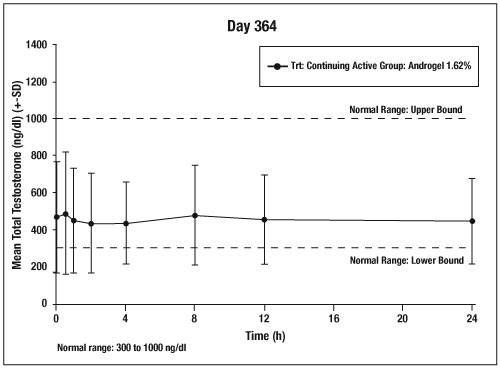
Figure 4: Mean (±SD) Steady-State Serum Total Testosterone Concentrations on Day 364
The mean estradiol and DHT concentration profiles paralleled the changes observed in testosterone. The levels of LH and FSH decreased with testosterone treatment. The decreases in levels of LH and FSH are consistent with reports published in the literature of long-term treatment with testosterone.
-
16 HOW SUPPLIED/STORAGE AND HANDLING
AndroGel 1.62% is supplied in non-aerosol, metered-dose pumps that deliver 20.25 mg of testosterone per complete pump actuation. The pumps are composed of plastic and stainless steel and an LDPE/aluminum foil inner liner encased in rigid plastic with a polypropylene cap. Each 88 g metered-dose pump is capable of dispensing 75 g of gel or 60-metered pump actuations; each pump actuation dispenses 1.25 g of gel.
AndroGel 1.62% is also supplied in unit-dose aluminum foil packets in cartons of 30. Each packet of 1.25 g or 2.5 g gel contains 20.25 mg or 40.5 mg testosterone, respectively.
NDC Number Package Size 0051-8462-33 88 g pump (each pump dispenses 60 metered pump actuations with each pump actuation containing 20.25 mg of testosterone in 1.25 g of gel) 0051-8462-12 Each unit dose packet contains 20.25 mg of testosterone provided in 1.25 g of gel 0051-8462-31 30 packets (each unit dose packet contains 20.25 mg of testosterone provided in 1.25 g of gel) 0051-8462-01 Each unit dose packet contains 40.5 mg of testosterone provided in 2.5 g of gel 0051-8462-30 30 packets (each unit dose packet contains 40.5 mg of testosterone provided in 2.5 g of gel) Store at controlled room temperature 20°-25°C (68°-77°F); excursions permitted to 15°- 30°C (59°- 86°F) [see USP Controlled Room Temperature].
Used AndroGel 1.62% pumps or used AndroGel 1.62% packets should be discarded in household trash in a manner that prevents accidental application or ingestion by children or pets.
-
17 PATIENT COUNSELING INFORMATION
See FDA-Approved Medication Guide
Patients should be informed of the following:
17.1 Use in Men with Known or Suspected Prostate or Breast Cancer
Men with known or suspected prostate or breast cancer should not use AndroGel 1.62% [see Contraindications (4) and Warnings and Precautions (5.1)].
17.2 Potential for Secondary Exposure to Testosterone and Steps to Prevent Secondary Exposure
Secondary exposure to testosterone in children and women can occur with the use of testosterone gel in men [see Warnings and Precautions (5.2)]. Cases of secondary exposure to testosterone have been reported in children.
Physicians should advise patients of the reported signs and symptoms of secondary exposure, which may include the following:
- In children: unexpected sexual development including inappropriate enlargement of the penis or clitoris, premature development of pubic hair, increased erections, and aggressive behavior.
- In women: changes in hair distribution, increase in acne, or other signs of testosterone effects.
- The possibility of secondary exposure to testosterone gel should be brought to the attention of a healthcare provider.
- AndroGel 1.62% should be promptly discontinued until the cause of virilization is identified.
Strict adherence to the following precautions is advised to minimize the potential for secondary exposure to testosterone from AndroGel 1.62% in men [see Medication Guide]:
- Children and women should avoid contact with unwashed or unclothed application site(s) of men using AndroGel 1.62%.
- Patients using AndroGel 1.62% should apply the product as directed and strictly adhere to the following:
- Wash hands with soap and water immediately after application.
- Cover the application site(s) with clothing after the gel has dried.
- Wash the application site(s) thoroughly with soap and water prior to any situation where skin-to-skin contact of the application site with another person is anticipated.
- In the event that unwashed or unclothed skin to which AndroGel 1.62% has been applied comes in contact with the skin of another person, the general area of contact on the other person should be washed with soap and water as soon as possible [see Dosage and Administration (2.2), Warnings and Precautions (5.2) and Clinical Pharmacology (12.3)].
17.3 Potential Adverse Reactions with Androgens
Patients should be informed that treatment with androgens may lead to adverse reactions which include:
- Changes in urinary habits such as increased urination at night, trouble starting the urine stream, passing urine many times during the day, having an urge to go to the bathroom right away, having a urine accident, being unable to pass urine and weak urine flow.
- Breathing disturbances, including those associated with sleep, or excessive daytime sleepiness.
- Too frequent or persistent erections of the penis.
- Nausea, vomiting, changes in skin color, or ankle swelling.
17.4 Patients Should Be Advised of the Following Instructions for Use
- Read the Medication Guide before starting AndroGel 1.62% therapy and to reread it each time the prescription is renewed.
- AndroGel 1.62% should be applied and used appropriately to maximize the benefits and to minimize the risk of secondary exposure in children and women.
- Keep AndroGel 1.62% out of the reach of children.
- AndroGel 1.62% is an alcohol based product and is flammable; therefore avoid fire, flame or smoking until the gel has dried.
- It is important to adhere to all recommended monitoring.
- Report any changes in their state of health, such as changes in urinary habits, breathing, sleep, and mood.
- AndroGel 1.62% is prescribed to meet the patient's specific needs; therefore, the patient should never share AndroGel 1.62% with anyone.
- Wait 2 hours before swimming or washing following application of AndroGel 1.62%. This will ensure that the greatest amount of AndroGel 1.62% is absorbed into their system.
AbbVie Inc.
North Chicago, IL 60064, USA
-
MEDICATION GUIDE
This Medication Guide has been approved by the U.S. Food and Drug Administration
Revised: 05/2019 -
INSTRUCTIONS FOR USE
INSTRUCTIONS FOR USE
ANDROGEL® (AN DROW JEL) CIII
(testosterone gel) 1.62%
for topical use
Read this Instructions for Use for ANDROGEL1.62% before you start using it and each time you get a refill. There may be new information. This leaflet does not take the place of talking to your healthcare provider about your medical condition or treatment.
- ANDROGEL 1.62% comes in a pump or in packets.
- Before applying ANDROGEL 1.62% make sure that your shoulders and upper arms are clean, dry, and that there is no broken skin.
- ANDROGEL 1.62% is to be applied to the area of your shoulders and upper arms that will be covered by a short sleeve t-shirt (See Figure A). Do not apply ANDROGEL 1.62% to any other parts of your body such as your stomach area (abdomen), penis, scrotum, chest, armpits (axillae), or knees.
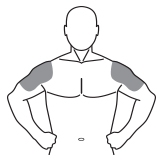
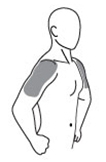
(Figure A) If you are using ANDROGEL 1.62% pump:
- Before using a new bottle of ANDROGEL 1.62 % for the first time, you will need to remove the cap and then prime the pump. To prime the ANDROGEL 1.62% pump, slowly push the pump all the way down 3 times, over the sink drain. Do not use any ANDROGEL 1.62% that came out while priming. Wash it down the sink to avoid accidental exposure to others. Your ANDROGEL 1.62% pump is now ready to use.
- Remove the cap from the pump. Then, put the spout opening at the top of the pump where the medicine comes out over the palm of your hand and slowly push the pump all the way down. Apply ANDROGEL 1.62% to the application site. You may also apply ANDROGEL 1.62% directly to the application site. Your healthcare provider will tell you the number of times to press the pump for each dose.
- Wash your hands with soap and water right away.
Find Your Dose as Prescribed by Your Healthcare Provider Application Method 1 pump 20.25 mg Apply 1 pump of ANDROGEL 1.62% to 1 upper arm and shoulder. 2 pumps 40.5 mg Apply 1 pump of ANDROGEL 1.62% to 1 upper arm and shoulder and then apply 1 pump of ANDROGEL 1.62% to the opposite upper arm and shoulder. 3 pumps 60.75 mg Apply 2 pumps of ANDROGEL 1.62% to 1 upper arm and shoulder and then apply 1 pump of ANDROGEL 1.62% to the opposite upper arm and shoulder. 4 pumps 81 mg Apply 2 pumps of ANDROGEL 1.62% to 1 upper arm and shoulder and then apply 2 pumps of ANDROGEL 1.62% to the opposite upper arm and shoulder. If you are using ANDROGEL 1.62% packets:
- Tear open the packet completely at the dotted line. Squeeze from the bottom of the packet to the top.
- Squeeze all of the ANDROGEL 1.62% out of the packet into the palm of your hand.
- Apply ANDROGEL 1.62% to the application site. You may also apply ANDROGEL 1.62% directly to the application site.
- Let the application site dry completely before putting on a t-shirt.
- ANDROGEL 1.62% is flammable until dry. Let ANDROGEL 1.62% dry before smoking or going near an open flame.
- Avoid showering, swimming or bathing for at least 2 hours after you apply ANDROGEL 1.62%.
- Wash your hands right away with soap and water after applying ANDROGEL 1.62%.
Find Your Dose as
Prescribed by Your
Healthcare ProviderApplication Method One 20.25 mg packet 20.25 mg Apply 1 packet of ANDROGEL 1.62% to 1 upper arm and shoulder. One 40.5 mg packet 40.5 mg Apply half of the 40.5 mg packet of ANDROGEL 1.62% to 1 upper arm and shoulder and then apply the remaining packet contents to the opposite upper arm and shoulder. One 40.5 mg packet
and one 20.25 mg
packet60.75 mg Apply one 40.5 mg packet of ANDROGEL 1.62% to 1 upper arm and shoulder and then apply one 20.25 mg packet of ANDROGEL 1.62% to the opposite upper arm and shoulder. Two 40.5 mg packets 81 mg Apply one 40.5 mg packet of ANDROGEL 1.62% to 1 upper arm and shoulder and then apply one 40.5 mg packet of ANDROGEL 1.62% to the opposite upper arm and shoulder. How should I store ANDROGEL 1.62%?
- Store ANDROGEL 1.62% at room temperature between 68ºF to 77ºF (20ºC to 25ºC).
- When it is time to throw away the pump or packets, safely throw away used ANDROGEL 1.62% in the household trash. Be careful to prevent accidental exposure of children or pets.
- Keep ANDROGEL 1.62% away from fire.
Keep ANDROGEL 1.62% and all medicines out of the reach of children.
This Instructions for Use has been approved by the U.S. Food and Drug Administration.
Revised: 05/2019 -
PRINCIPAL DISPLAY PANEL
Clear, colorless gel provides transdermal delivery of testosterone through the skin of the shoulders, and upper arms*
AndroGel® (testosterone gel) 1.62% CIII
Contains 20.25 mg of testosterone in 1.25 Grams of gel per unit dose
Topical testosterone products may have different doses, strengths, or application instructions that may result in different systemic exposure. Dispense the enclosed Medication Guide to each patient.
*See accompanying package insert.
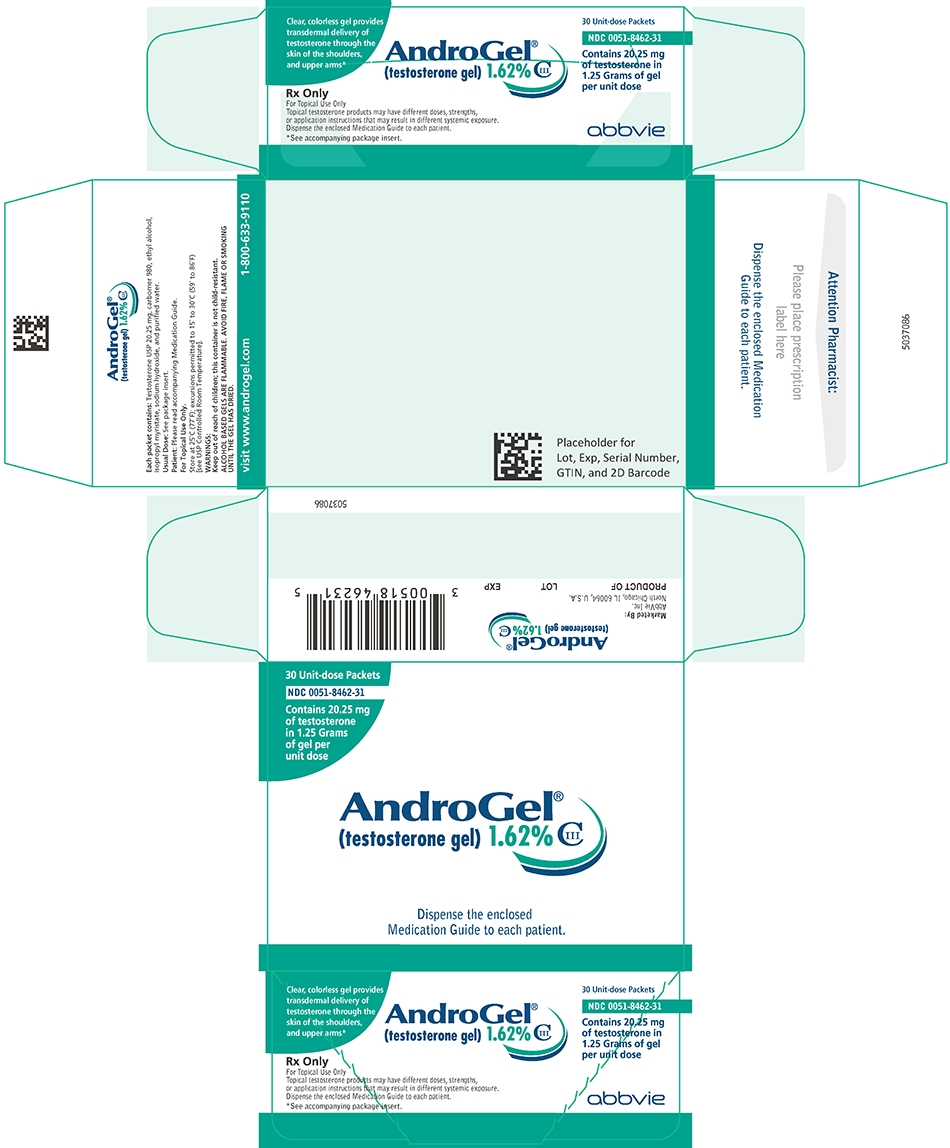
Clear, colorless gel provides transdermal delivery of testosterone through the skin of the shoulders, and upper arms*
AndroGel® (testosterone gel) 1.62% CIII
Contains 40.5 mg of testosterone in 2.5 Grams of gel per unit dose
Topical testosterone products may have different doses, strengths, or application instructions that may result in different systemic exposure. Dispense the enclosed Medication Guide to each patient.
* See accompanying package insert.
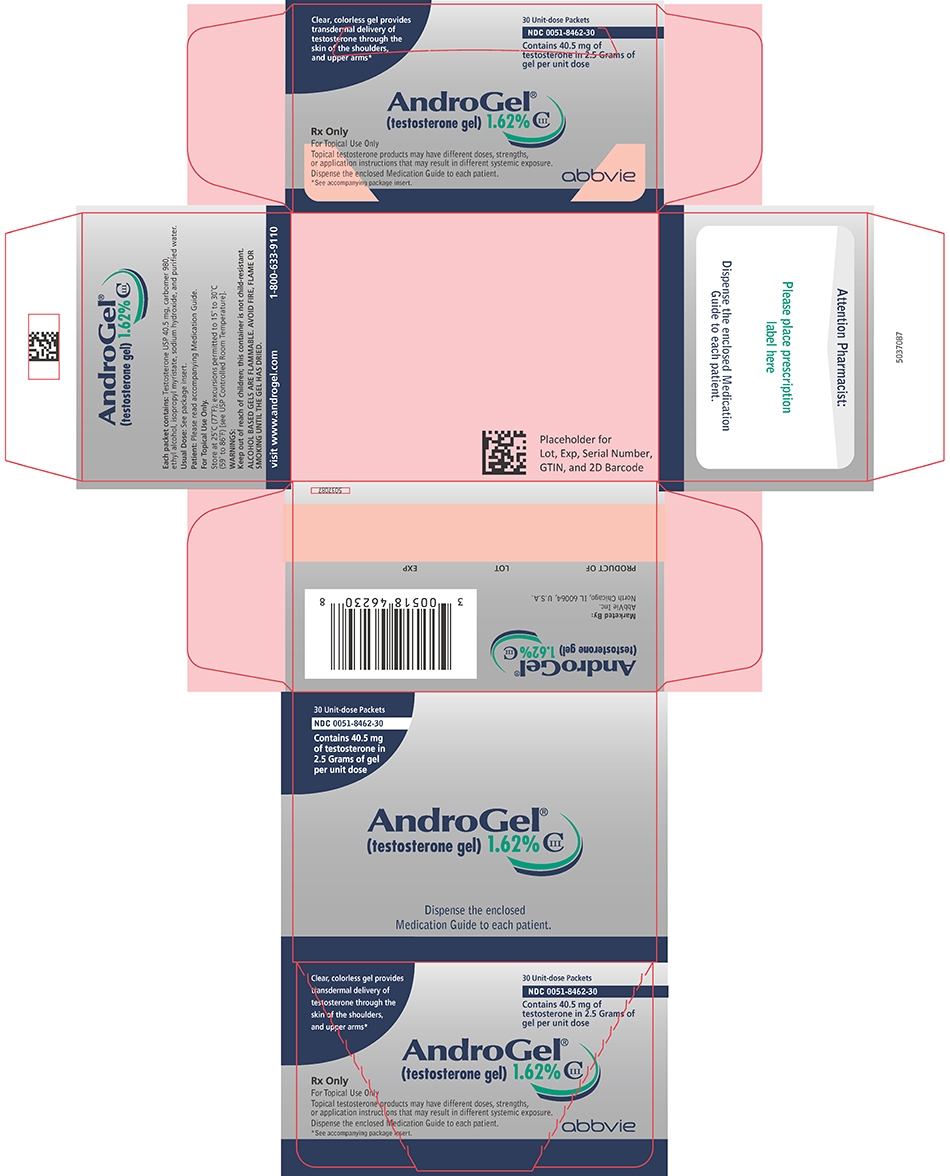
Dispense the accompanying Medication Guide to each patient.
AndroGel® (testosterone gel) 1.62% CIII
20.25 mg of testosterone per pump actuation*
*Each actuation delivers 1.25 g of gel
Topical testosterone products may have different doses, strengths, or application instructions that may result in different systemic exposure.
Multi-dose pump capable of dispensing 60 metered pump actuations.
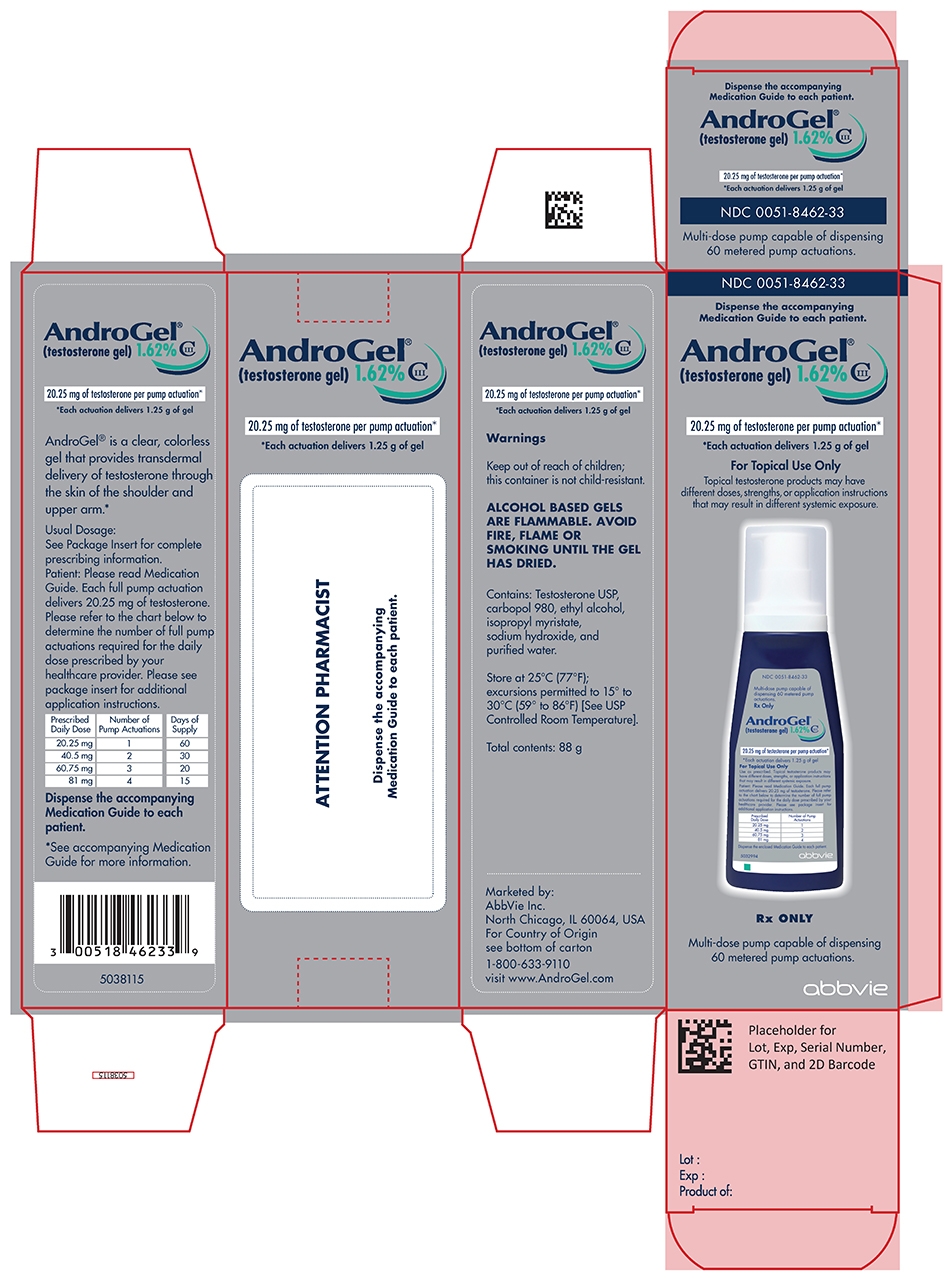
-
INGREDIENTS AND APPEARANCE
ANDROGEL
testosterone gelProduct Information Product Type HUMAN PRESCRIPTION DRUG Item Code (Source) NDC: 0051-8462 Route of Administration TRANSDERMAL DEA Schedule CIII Active Ingredient/Active Moiety Ingredient Name Basis of Strength Strength testosterone (UNII: 3XMK78S47O) (testosterone - UNII:3XMK78S47O) testosterone 16.2 mg in 1 g Inactive Ingredients Ingredient Name Strength alcohol (UNII: 3K9958V90M) isopropyl myristate (UNII: 0RE8K4LNJS) water (UNII: 059QF0KO0R) sodium hydroxide (UNII: 55X04QC32I) CARBOMER HOMOPOLYMER TYPE C (ALLYL PENTAERYTHRITOL CROSSLINKED) (UNII: 4Q93RCW27E) Packaging # Item Code Package Description Marketing Start Date Marketing End Date 1 NDC: 0051-8462-33 1 in 1 CARTON 04/29/2011 1 88 g in 1 BOTTLE, PUMP; Type 0: Not a Combination Product 2 NDC: 0051-8462-31 30 in 1 CARTON 04/29/2011 2 NDC: 0051-8462-12 1.25 g in 1 PACKET; Type 0: Not a Combination Product 3 NDC: 0051-8462-30 30 in 1 CARTON 04/29/2011 3 NDC: 0051-8462-01 2.5 g in 1 PACKET; Type 0: Not a Combination Product Marketing Information Marketing Category Application Number or Monograph Citation Marketing Start Date Marketing End Date NDA NDA022309 04/29/2011 Labeler - AbbVie Inc. (078458370)
Trademark Results [Androgel]
Mark Image Registration | Serial | Company Trademark Application Date |
|---|---|
 ANDROGEL 75484512 not registered Dead/Abandoned |
EICKENBERG, HANS-UDO 1998-05-13 |
 ANDROGEL 74721663 2232508 Live/Registered |
Unimed Pharmaceuticals, LLC 1995-08-28 |
 ANDROGEL 73560566 not registered Dead/Abandoned |
LABORATOIRES BESINS ISCOVESCO 1985-09-27 |
© 2025 FDA.report
This site is not affiliated with or endorsed by the FDA.